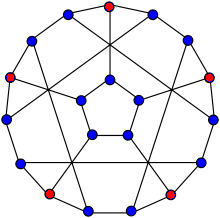Snark Graphs
To understand what a snark graph is we need to define
some things first:
- In graph theory, a bridge is a edge if and only if is not contained in any cycle. A graph with no bridges is a bridgeless graph.
- The edge chromatic number of a graph G is fewest number of colors necessary to color each edge of G such that no two edges incident on the same vertex have the same color.
A snark is a connected bridgeless cubic graph with edge chromatic number of four. By Vizing's theorem, the edge chromatic number of every cubic graph is either three or four, so a snark corresponds to the special case of four. Snarks are therefore class 2 graphs.We can see an example on Fig. 1.
Snark graphs are interesting because we know so little about them. Writting in The Electronic Journal of Combinatorics, Miroslav Chladny states that:
"In the study of various important and difficult
problems in graph theory (such as the Cycle double cover conjecture and the
5-Flow Conjecture), one 4encounters an interesting but somewhat mysterious
variety of graphs called snarks. In spite of their simple denition...and over
a century long investiga- tion, their properties and structure are largely
unknown.[1]"

Snark input file
SnarksDominating set in snarks
There's not a lot of studies of dominating set on snark graphs. So I present instead, the results of my program for some of the snark graphs in the input file.- (1,1)Blanusa snark - 18 vertices:
Minumum dominating set of size: 5 - Flower snark J5 - 20 vertices:
Minimum dominating set of size 6 - Double star graph - 30 vertices:
Minimum dominating set of size: 8 - Flower snark J7 - 28 vertices:
Minumum dominating set of size: 7 - Goldberg snark 7 - 56 vertices:
Minimum dominating set of size: 16 - Loupekine's first snark - 22 vertices:
Minimum dominating set of size: 6
References
- Chladny, Miroslav; Martin Skoviera. Factorisation of snarks. The Electronic Journal of Combinatorics, 17:R32, 2010.